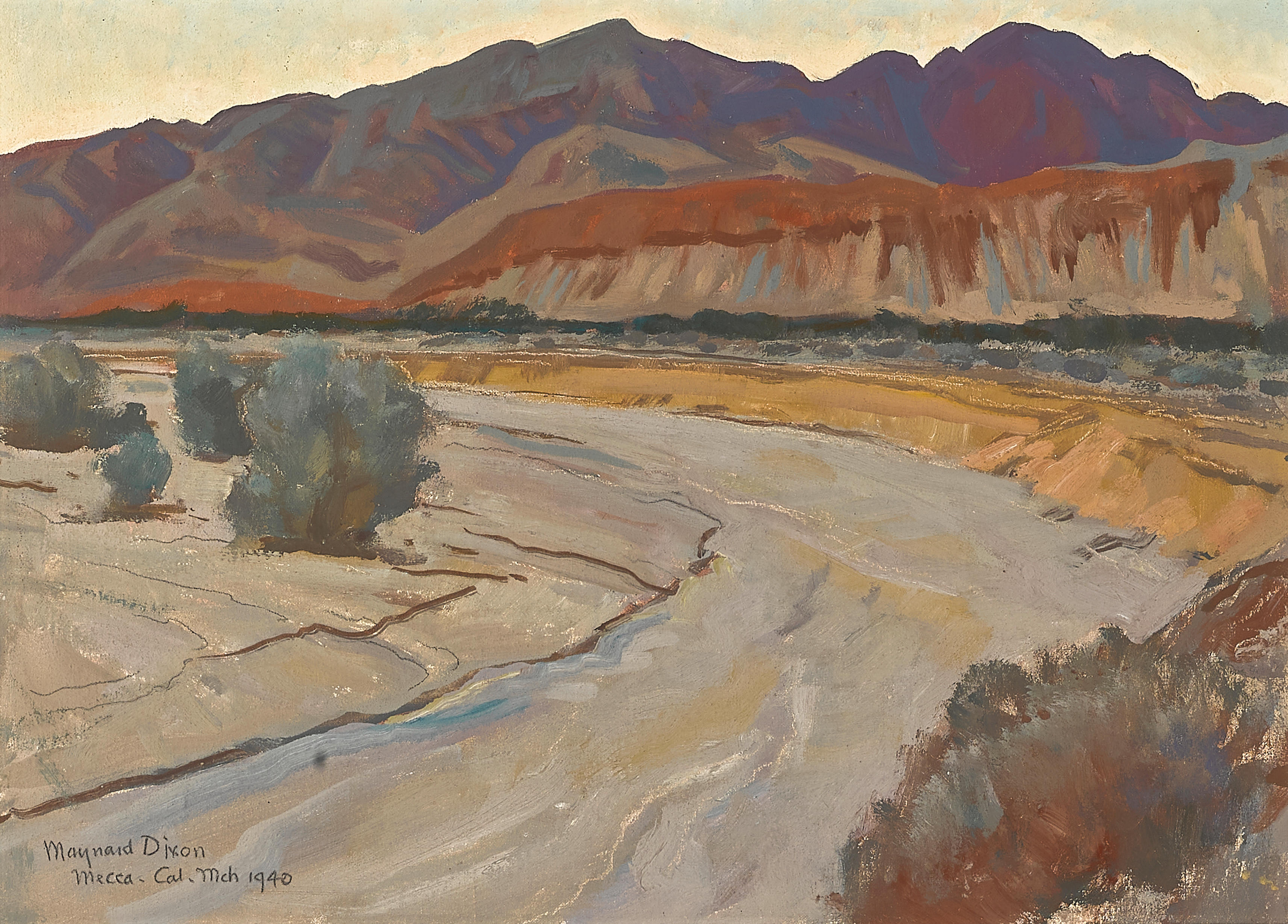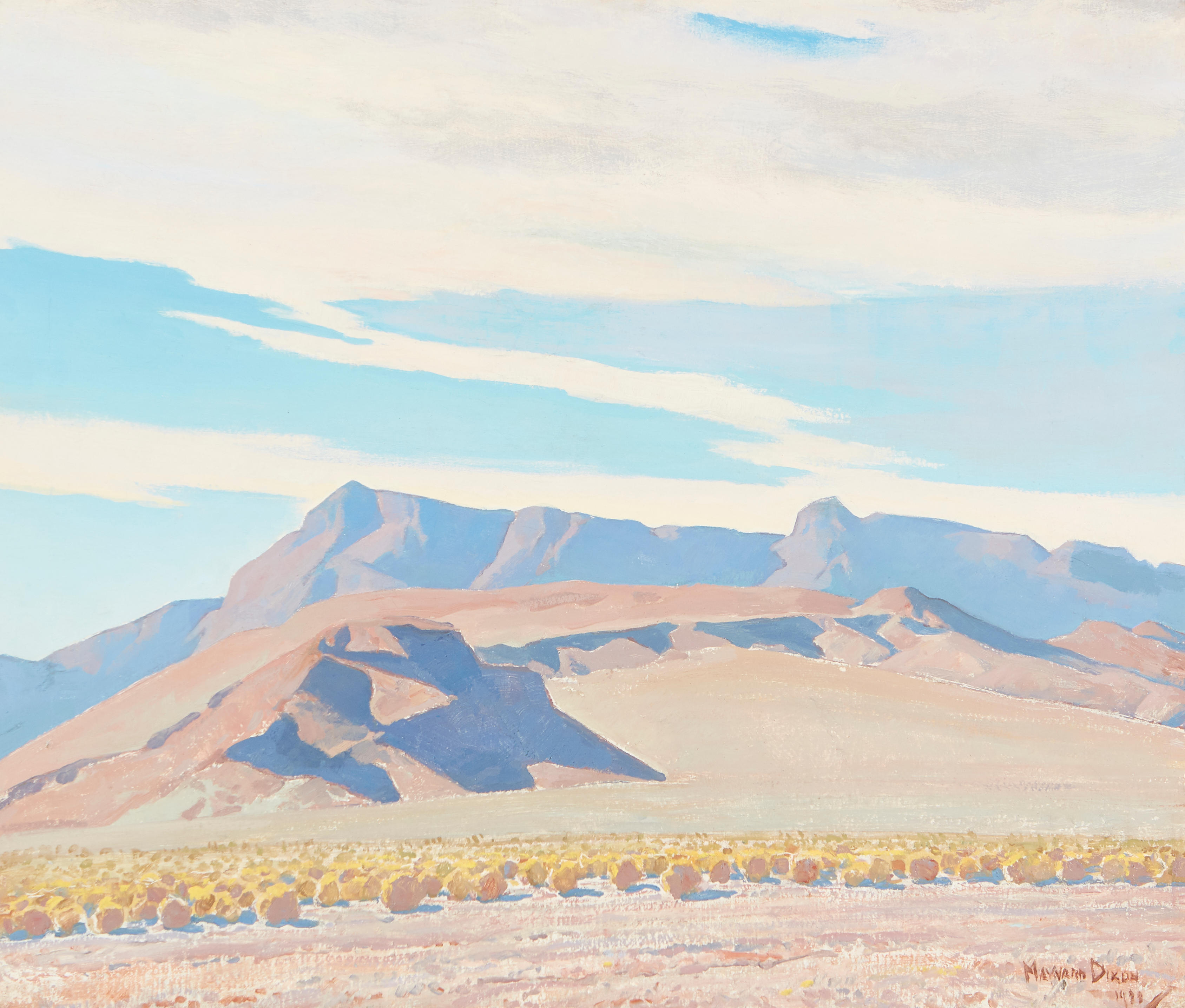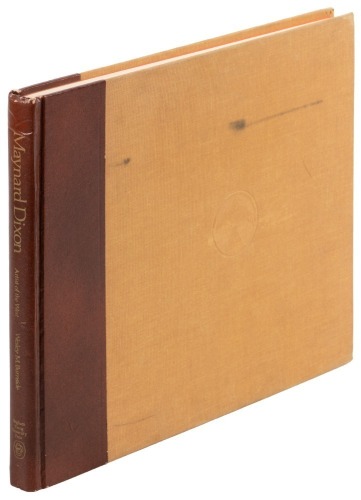Maynard Dixon (1875-1946)Glory After Storm signed, inscribed and dated 'Maynard Dixon Ariz. 1944' (lower right) and signed again and titled (on the reverse) oil on canvas laid to artist's board 20 x 16 in. framed 35 x 20 1/2 in.FootnotesProvenance Gump's, San Francisco, California, 1945. Property from an Important Bay Area Collection. Literature Wesley M. Burnside, Maynard Dixon Artist of the West, Brigham Young University Press, Provo, Utah, 1974, p. 190. Born in the vast flatlands of the San Joaquin Valley in 1875, Maynard Dixon was afflicted with asthma from an early age. Because of his illness, Dixon led a quiet childhood sketching and listening to the tall tales of Native Americans and cowboys told by his paternal grandfather and six uncles. These stories pushed Dixon to develop a lifelong fascination with the lives of the settlers of the American West and the Indigenous peoples who originally inhabited the land. Dixon's artistic skill was recognized early in his life. Living in rural California provided little access to formal art instruction, so Dixon turned to the engravings in periodicals such as Scribner's and Harper's Weekly to improve his technique. Through these publications, Dixon became familiar with the work of contemporary artists illustrating the American West, chief amongst them Frederic Remington Remington's dramatic and technical depictions left an indelible impression on young Dixon, and at age 16, Dixon sent two sketch books to Remington for criticism and advice. On September 3, 1891, Remington responded with support and enthusiasm to 'draw, draw, draw'. Encouraged by this response, Dixon enrolled at the School of Design in San Francisco in the same year, though found formal training to be stifling and left before the end of the year. For the next 30 years, Dixon would bounce around as a cowpuncher and building a career as a magazine illustrator depicting his extensive travel throughout the United States. In 1920, Maynard Dixon married social commentary photographer Dorothea Lange Shortly after this union began, Dixon shifted his energy to focus on painting murals. The large surface area of mural painting taught him to distill his painting style into simple but powerful compositions with hard horizon lines and vivid colors of the unfettered beauty of the American desert landscape. Two years after his marriage to Lange ended, Dixon married artist Edith Hamlin in 1937. The two frequently painted side by side, sometimes working on the same piece. As Dixon's health declined, they made the decision to move to the drier climate of Arizona. They first moved into a home and studio in Mount Carmel, Utah in summer 1940 while a Mexican colonial style home and studio was being constructed in Tucson. 1 The Tucson residence was finished in April 1941, and they split their time between the two locations each year, generally spending winter and spring in the Sonoran Desert enjoying views of the Santa Catalina Mountains, and summer and fall in the cooler climate of Utah. 2 Dixon's Tucson studio "...window looked beyond the Rillito to the Catalinas which he painted repeatedly in the molten light of the dying day. Painters of the desert are innumerable. There has been only one who painted it as Dixon did, 'Where many have looked, ' wrote Arthur Millier, 'he is one of the few who have really seen. His vision of the West is so true that we have come to see the region through the forms and colors of his paintings. Thus great artists teach us to see nature.'" 3 The present work's title speaks directly to the stunning composition. Viewed from the artist's studio window, Glory After Storm's cumulonimbus formations roil over the Santa Catalina Mountain range. As he often does, Dixon plays with distinct spatial separation and horizontal layers leading the eye toward the deepest parts of the composition and then upward toward the sky. Sunlit cloud and mountain highlights and deep shadows add to the dramatic post-storm landscape.
Maynard Dixon (1875-1946)Glory After Storm signed, inscribed and dated 'Maynard Dixon Ariz. 1944' (lower right) and signed again and titled (on the reverse) oil on canvas laid to artist's board 20 x 16 in. framed 35 x 20 1/2 in.FootnotesProvenance Gump's, San Francisco, California, 1945. Property from an Important Bay Area Collection. Literature Wesley M. Burnside, Maynard Dixon Artist of the West, Brigham Young University Press, Provo, Utah, 1974, p. 190. Born in the vast flatlands of the San Joaquin Valley in 1875, Maynard Dixon was afflicted with asthma from an early age. Because of his illness, Dixon led a quiet childhood sketching and listening to the tall tales of Native Americans and cowboys told by his paternal grandfather and six uncles. These stories pushed Dixon to develop a lifelong fascination with the lives of the settlers of the American West and the Indigenous peoples who originally inhabited the land. Dixon's artistic skill was recognized early in his life. Living in rural California provided little access to formal art instruction, so Dixon turned to the engravings in periodicals such as Scribner's and Harper's Weekly to improve his technique. Through these publications, Dixon became familiar with the work of contemporary artists illustrating the American West, chief amongst them Frederic Remington Remington's dramatic and technical depictions left an indelible impression on young Dixon, and at age 16, Dixon sent two sketch books to Remington for criticism and advice. On September 3, 1891, Remington responded with support and enthusiasm to 'draw, draw, draw'. Encouraged by this response, Dixon enrolled at the School of Design in San Francisco in the same year, though found formal training to be stifling and left before the end of the year. For the next 30 years, Dixon would bounce around as a cowpuncher and building a career as a magazine illustrator depicting his extensive travel throughout the United States. In 1920, Maynard Dixon married social commentary photographer Dorothea Lange Shortly after this union began, Dixon shifted his energy to focus on painting murals. The large surface area of mural painting taught him to distill his painting style into simple but powerful compositions with hard horizon lines and vivid colors of the unfettered beauty of the American desert landscape. Two years after his marriage to Lange ended, Dixon married artist Edith Hamlin in 1937. The two frequently painted side by side, sometimes working on the same piece. As Dixon's health declined, they made the decision to move to the drier climate of Arizona. They first moved into a home and studio in Mount Carmel, Utah in summer 1940 while a Mexican colonial style home and studio was being constructed in Tucson. 1 The Tucson residence was finished in April 1941, and they split their time between the two locations each year, generally spending winter and spring in the Sonoran Desert enjoying views of the Santa Catalina Mountains, and summer and fall in the cooler climate of Utah. 2 Dixon's Tucson studio "...window looked beyond the Rillito to the Catalinas which he painted repeatedly in the molten light of the dying day. Painters of the desert are innumerable. There has been only one who painted it as Dixon did, 'Where many have looked, ' wrote Arthur Millier, 'he is one of the few who have really seen. His vision of the West is so true that we have come to see the region through the forms and colors of his paintings. Thus great artists teach us to see nature.'" 3 The present work's title speaks directly to the stunning composition. Viewed from the artist's studio window, Glory After Storm's cumulonimbus formations roil over the Santa Catalina Mountain range. As he often does, Dixon plays with distinct spatial separation and horizontal layers leading the eye toward the deepest parts of the composition and then upward toward the sky. Sunlit cloud and mountain highlights and deep shadows add to the dramatic post-storm landscape.


.jpg)











Testen Sie LotSearch und seine Premium-Features 7 Tage - ohne Kosten!
Lassen Sie sich automatisch über neue Objekte in kommenden Auktionen benachrichtigen.
Suchauftrag anlegen